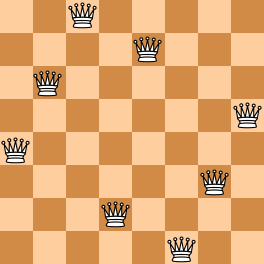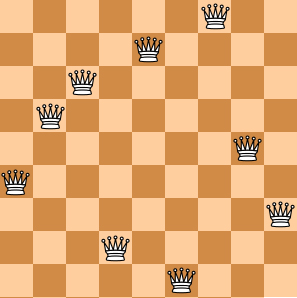The "eight queens puzzle" is the problem of placing eight chess queens on an 8×8 chessboard so that no two queens threaten each other. Thus, a solution requires that no two queens share the same row, column, or diagonal. The eight queens puzzle is an example of the more general N queens problem of placing N non-attacking queens on an N×N chessboard. (From Wikipedia - "Eight queens puzzle".)
Here you are NOT asked to solve the puzzles. Instead, you are supposed to judge whether or not a given configuration of the chessboard is a solution. To simplify the representation of a chessboard, let us assume that no two queens will be placed in the same column. Then a configuration can be represented by a simple integer sequence (Q1 ,Q
2 ,⋯,QN ), where Qi is the row number of the queen in the i-th column. For example, Figure 1 can be represented by (4, 6, 8, 2, 7, 1, 3, 5) and it is indeed a solution to the 8 queens puzzle; while Figure 2 can be represented by (4, 6, 7, 2, 8, 1, 9, 5, 3) and is NOT a 9 queens' solution.


Input Specification:
Each input file contains several test cases. The first line gives an integer K (1<K≤200). Then K lines follow, each gives a configuration in the format "N Q1 Q2 ... QN ", where 4≤N≤1000 and it is guaranteed that 1≤Qi ≤N for all i=1,⋯,N. The numbers are separated by spaces.
Output Specification:
For each configuration, if it is a solution to the N queens problem, print YES in a line; or NO if not.
Sample Input:
4
8 4 6 8 2 7 1 3 5
9 4 6 7 2 8 1 9 5 3
6 1 5 2 6 4 3
5 1 3 5 2 4
Sample Output:
YES
NO
NO
YES
#include<iostream> //水题
#include<vector>
#include<math.h>
using namespace std;
int main(){
int n, m;
cin>>n;
for(int i=0; i<n; i++){
int flag=0;
cin>>m;
vector<int> v(m+1, 0), visited(m+1, 0);
for(int j=1; j<=m; j++){
cin>>v[j];
if(visited[v[j]]==0) //判断同一行是否有两个点
visited[v[j]]=1;
else
flag=1;
}
for(int p=1; p<v.size(); p++){ //判断是否对角线上有两个点
for(int q=p+1; q<v.size(); q++)
if(abs(p-q)==abs(v[p]-v[q])){
flag=1;
break;
}
if(flag==1) break;
}
if(flag==1) cout<<"NO"<<endl;
else cout<<"YES"<<endl;
}
return 0;
}